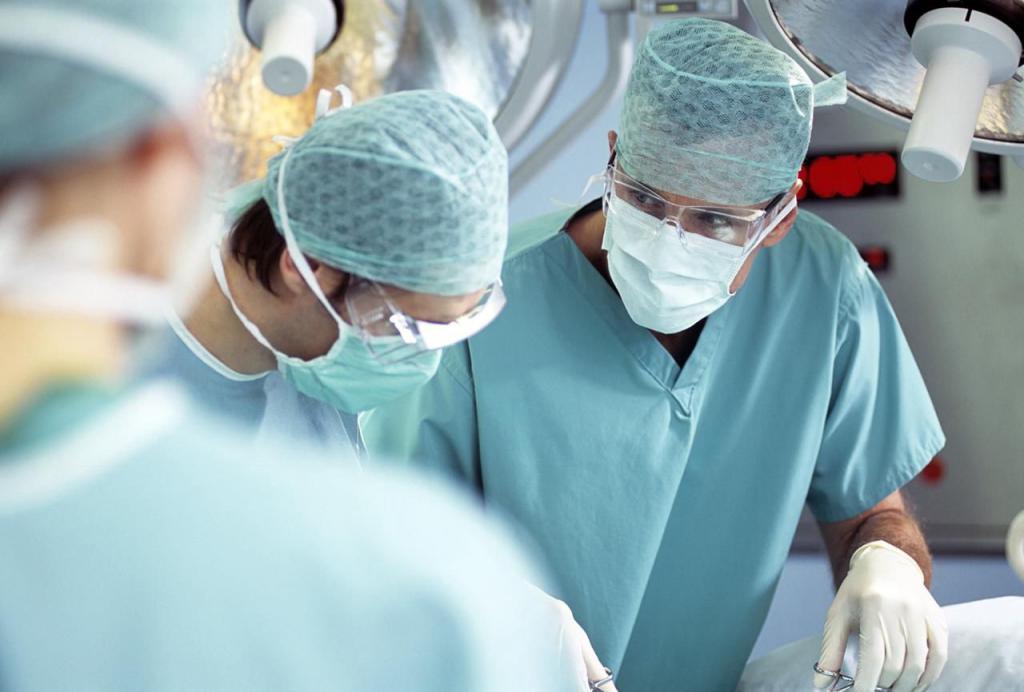In the article, we will consider how the removal of the Bartholin gland cyst takes place.
This is a pathological phenomenon that is often found in gynecology and is diagnosed mainly in women of reproductive age who lead an active sex life. With any infectious and inflammatory processes, the excretory duct of this gland becomes blocked. The liquid begins to accumulate in the cavity, the labia swell, a small round formation develops in them. If its size is small, it usually does not cause the patient much discomfort, however, if the tumor grows and is complicated by suppuration, surgical intervention is necessary to remove the Bartholin's gland cyst. A woman is offered marsupialization, extirpation or husking of a neoplasm.

When is surgery necessary?
If the tumor is small (no more than 2.5 centimeters), then surgical intervention is not necessary. In this situation, the patient should be constantly monitored by a gynecologist who, with the help of ultrasound, monitors the development of the disease. In some situations, the cyst can dissolve on its own without pharmacological effects. However, cystic neoplasms that have reached large sizes are always removed in an operable way. Hope that a tumor with a size of 7-10 cm will resolve, meaningless.
Drug therapy is carried out without fail, if during the diagnosis the patient found:
- fungal and genital infections;
- Escherichia coli infection;
- other inflammatory and infectious pathologies.
After identifying the causative agent of the disease, the gynecologist should prescribe appropriate medications. Basically, they use broad-spectrum antibiotics and antimicrobials to prevent the development of a purulent inflammatory process. Local treatment is also carried out using disinfectant solutions and antiseptic ointments.
Large cyst
Surgical intervention is necessary in cases where the size of the cystic formation has greatly increased, since a large tumor prevents the patient from leading a normal lifestyle. With frequent exacerbations of this pathology, cyst removal is carried out regardless of the size of a benign neoplasm. Surgical treatment is carried out in various ways, depending on the degree and form of the pathological process, the presence of complications and the general well-being of the patient.
In what cases is removal of a Bartholin gland cyst indicated?
Indications for the operation
The main indications for surgical intervention:
- acute or recurring abscesses;
- rapid tumor development;
- with inflammatory purulent processes;
- non-healing fistulas after self-resolution of the abscess;
- soreness and discomfort.

Bursting cyst
With a bursting cyst, the pathological process is accompanied by intolerable pains. With such symptoms, an emergency removal of the bartholin glands is carried out, after which the patient is prescribed antibiotic therapy. Such manipulations are performed under general anesthesia. With the complete removal of this organ, various consequences are possible.
How is the removal of the Bartholin gland cyst?
First of all, surgical intervention is indicated for purulent inflammatory processes. Previously, a specialist can prescribe antibacterial therapy. In some cases, such a therapeutic regimen allows non-surgical way to eliminate the manifestations of the inflammatory process of the excretory duct, as well as restore its patency.
Classical opening of a benign tumor and cleaning with disinfectant medicines is by no means always an effective method, as in many cases relapses are observed in women. Through the genital tract, a woman gets various infections. If you do not restore the excretory ducts of the gland, then negative consequences are inevitable. After surgical procedures, physiotherapy and immunostimulating therapy are mandatory.
Complete removal of the gland
In some cases, experts recommend resorting to extreme measures, which include the complete removal of the gland, this allows 100% avoid exacerbations.
Extirpation of the gland is the most radical type of surgical treatment.
An operation to remove a gland cyst is prescribed if other types of therapeutic effects do not give positive dynamics. Using extirpation, you can once and for all forget about such a problem. However, after the operation, a significant decrease in the quality of sexual life is possible: dryness of the vaginal mucosa due to poor functioning of the only gland, which entails unpleasant sensations and discomfort during sexual intercourse.

In addition, the seam may be disturbed after removal of the Bartholin gland cyst.
After removal of the cyst, a large scar remains in the surgical area, a fistula or hematoma may occur. Damage to the venous walls during manipulation is fraught with the development of bleeding. Removal is carried out under general anesthesia, therefore, operations are performed only in women who normally tolerate anesthesia. Hospitalization in a medical institution lasts about a week, in case of complications, the postoperative period can last up to a month. Given the above consequences, the complete removal of bartholin gland is subject only in severe cases with regular relapses of the pathological process.
In chronic form
In the chronic form of the disease, relapses often occur, autopsy of abscesses and secondary infection can occur. Autopsy education should be carried out only in a hospital, where proper antiseptic treatment is carried out, the cavity is cleansed of purulent contents, proper wound care.
It is not possible to completely free the cavity from pus at home. And if an infection enters the bloodstream, sepsis can develop, which without the timely help of doctors can provoke a patient’s death. The most popular laser removal of Bartholin gland cysts.

Gentle surgical methods
There are several methods of surgical treatment of cysts, which are aimed not only at opening the formation and removal of pathological secretions, but also at developing a new excretory duct. The main methods for performing an operation to remove a Bartholin gland cyst can be as follows:
- Marsupialization of the cyst is a method aimed at the formation of a new excretory duct. A similar operation lasts approximately 30 minutes. Everything goes on an outpatient basis using anesthesia. After anesthesia, the doctor makes a dissection of the labia, removes the pathological formation along with its contents, and rinses the cavity with an antiseptic solution. A catheter is inserted to drain the fluid. If the area of surgical intervention is strongly swollen, then an incision is made both on the mucous membrane and on the cyst. After this, the cyst membrane is sutured, forming a new excretory duct. Subsequent rehabilitation takes place without drug therapy. This technique allows you to normalize the functioning of the gland, eliminate the inflammatory process, prevent the development of an abscess.
- Cyst husking is a manipulation in which an autopsy of the cystic formation is performed, followed by drainage of the gland. The cyst is husked and treated with antiseptic agents. After surgical treatment, drainage is inserted, through which accumulated fluid flows from the cavity. After complete healing, the catheter is removed, and a new excretory duct develops in its place. This is a rather complicated operation that requires great care. During the procedure, a specialist incisions tissues in the labia minora, while trying not to touch the cyst so that it does not burst, otherwise its contents may get into the wound, causing an infection process. The operation for husking a Bartholin's cyst is performed on an outpatient basis under local anesthesia. After its completion, the patient is prescribed antibiotics, physiotherapy and immunomodulators.

- Laser removal of Bartholin gland cysts is a popular and highly effective method with a huge number of advantages. High precision of laser beams allows not to affect healthy tissues. Under the influence of the laser, the neoplasm is instantly evaporated, as a result, the excretory duct is cleaned and resumes its physiological functions. Laser removal of Bartholin gland cysts is a painless and bloodless procedure, the duration of which is only 10 minutes, and there is no need for hospitalization of the patient. After removal of the Bartholin gland cyst by a laser, the body quickly recovers, there is a minimal likelihood of repeated exacerbations. The only negative is the high cost of such an operation, since vaporization is carried out using expensive tools.
- The installation of a word catheter is one of the new modern methods for removing cysts of the Bartholin gland, which involves opening the cyst and treating its cavity, after which a silicone catheter in the form of a tube with a bag is placed inside. Such a design does not allow the walls of the cystic cavity to overgrow and the duct remains open. After a month, the catheter is removed, as the cavity is filled with epithelial cells. The operation lasts about 10 minutes, subsequently does not cause complications. After the procedure, prior to removal of the catheter and healing of the operated site, sexual contact is prohibited. The main advantage of this technique is the very low probability of relapse.
- Cyst aspiration, which is a fairly simple procedure, which is carried out if necessary, the evacuation of the internal contents of the cystic formation. During this procedure, a long needle is inserted into the center of the cyst, after which the pathological secret is pumped out with a syringe. During the operation, ultrasound is performed. The fluid is sent for a cytological examination to establish the cause of the development of the pathology. Basically, this method is used during pregnancy, when other methods of surgical treatment are contraindicated. The main advantage is that after removal of the Bartholin gland cysts, there are no sutures. However, after aspiration, the excretory duct of the gland is not fully restored, and in most cases, after a certain time, the pathological formation forms again.
Postoperative period and recovery
After removal of the Bartholin gland cyst, the postoperative period proceeds differently in everyone.
To reduce the likelihood of postoperative complications, the patient is prescribed anti-inflammatory medications, as well as physiotherapy. Prior to wound healing, it is necessary to refrain from sexual intercourse.
Recovery after removal of the Bartholin gland cyst usually occurs quickly.
If a complete removal of the gland has been performed, the postoperative period is delayed for a long time. Strong hematomas and swelling appear in the vulvar region, which disappear very slowly.

Recovery after removal of the Bartholin gland, as in the case of excision of the cyst, is associated with the elimination of pathogens that caused the pathology. Antibiotics are prescribed to achieve the following goals:
- reducing the risk of spreading the infection throughout the body (for example, women with immunodeficiency or pregnant patients);
- elimination of symptoms of systemic infection (fever, fever);
- the fight against pathogens of gonorrhea, chlamydia, methicillin-resistant Staphylococcus aureus, found in the process of examining pus from a cyst.
The most suitable method of surgical treatment is selected by the attending specialist, after which coordination with the patient is carried out.
Prevention
For preventive purposes, women need to use barrier contraceptives, observe personal hygiene rules, including during and after intimate relationships, fully treat inflammatory and infectious diseases, and visit gynecologists once every six months. In addition, young girls and women of reproductive age need to ensure that their legs are always warm, to avoid hypothermia, which is the most common cause of this disease. What happens after surgery to remove a Bartholin's cyst? The following are reviews of women who have had surgery.
Reviews
Bartholin's cyst to date occurs in approximately 9 out of 100 women, and these are very high rates. What is the reason for such a frequent development of this pathology, doctors do not yet reliably know, however, in clinics at the moment, patients can be offered several ways to quickly resolve this problem.

There are a lot of reviews about the removal of the Bartholin gland cyst, and they are very diverse. Judging by the information contained in them, the extirpation of the gland is most often performed. Women who have undergone such surgical treatment say that this is the most radical method of therapy in especially advanced cases. Relapses after it do not occur, but there are many other negative consequences. The main complication is that the secretion of the gland is disrupted in patients, which makes the vaginal mucosa constantly dry, which causes inconvenience not only during intercourse, but also during life.
The most optimal technique is, according to patients, laser treatment. After removal of the Bartholin gland cyst in such a way, as women say, health is quickly restored, relapses are extremely rare, there are no negative consequences. According to patients, this is the most gentle method of therapy and the most painless.